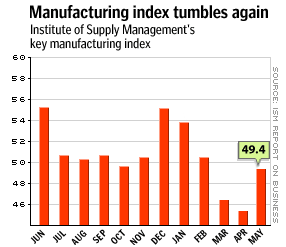NEW YORK (CNN/Money) - U.S. manufacturing activity shrank for a third straight month in May, the nation's purchasing managers said Monday, but it was stronger than economists expected, raising Wall Street hopes for a broader economic recovery.
Still, many economists warned the factory-sector report didn't spell a certain return to full growth potential, and the labor market could remain weak for some time.

The Institute for Supply Management said its index of manufacturing activity rose to 49.4 from 45.4 in April. Any number below 50 indicates contraction in the sector. Economists, on average, expected the ISM index to rise to 47.6, according to a Reuters poll.
The report's details offered a wide array of hopeful signs:
- the "new orders" index rose to 51.9 from 45.2 in April, indicating stronger activity would continue
- the production index rose to 51.5 from 47 in April
- the employment index rose to 43 from 41.4 in April, indicating the pace of layoffs in the manufacturing sector slowed in May
- the "prices-paid" index plunged to 51.5 from 63.5, likely reflecting a decline in energy prices.
"These are all signs of encouragement that manufacturing is recovering from the decline due to the war," said Norbert Ore, chairman of the ISM's Business Survey Committee.
Following the ISM report and a Commerce Department report that construction spending fell in April, U.S. stock prices added to their earlier gains, while Treasury bond prices continued to fall.
"What a stark difference in investor sentiment compared with several months ago," said John Forelli, portfolio manager at Independence Investments in Boston. "Even though investors know the economy is very weak and still vulnerable to a relapse, they believe that, bit by bit, the vital signs are improving."
Recent gauges of manufacturing activity in the New York and Chicago regions have pointed to a rebound in factory activity, raising traders' hopes for an upbeat ISM report.
| Related stories
|

|
|
|
|
Still, the U.S. manufacturing sector has been on the ropes for years; competition from China and other overseas sources of cheaply made goods, means the U.S. factory sector's glory days likely are gone for good. The ISM index first fell below 50 in August 2000 and stayed there until January 2002. About 2 million manufacturing jobs were cut during that time.
Manufacturing eked out some gains in 2002. But it suffered late in the year, along with other businesses, from fears about the possibility of war, leading to a Fed rate cut in November. Manufacturing recovered again in the winter, until the buildup to the U.S.-led war with Iraq brought it back down.
Since the war, however, oil prices have fallen, consumer confidence has risen, the dollar has lost strength, and stock prices have posted consistent gains, raising hopes for an economic rebound in the second half of the year -- and the ISM report would seem to be a first step in making those hopes come true.
"The manufacturing sector has been so battered that it's too early to say the troubles are over in that sector," said former Federal Reserve economist Lara Rhame, now an economist with Brown Brothers Harriman. "But we're seeing the economy making some kind of a bounce after contracting in April. We have to see now whether or not that continues."
Some economists thought the ISM report would be enough to keep the Fed from cutting its target for short-term interest rates at its next policy meeting, scheduled for June 24 and 25, particularly since policy makers expect the economy to get some lift, however small, from the tax cuts passed recently by Congress and from already low interest rates.
"Skeptics will argue this is just a post-war bounce that won't last, but we disagree," said Ian Shepherdson, chief U.S. economist at High Frequency Economics Ltd. "The ISM was in the mid-50s before the war, thanks to very loose policy, and there's no reason why it can't return to those levels very soon. The Fed does not need to ease again."
Labor market weakness could linger
The one glaring problem with optimism about the economy so far has been the lingering weakness in the labor market, which has pushed the unemployment rate up to match a nine-year high. But since the ISM index is essentially a measure of business confidence, it could mean businesses will be more likely to hire in the future.
The Labor Department is scheduled to report on May unemployment and payrolls changes Friday. Economists, on average, expect unemployment to rise to 6.1 percent and 26,000 jobs to be shed from non-farm payrolls, according to a Reuters report.
While he was encouraged by the ISM report, Northern Trust senior economist Paul Kasriel said he still expected the Fed to cut rates at its next policy meeting.
For one thing, though manufacturing has rebounded, it could face a difficult second half if recent weakness in automobile sales continues, leading to a slowdown in auto production and more layoffs in the sector.
And strength in the factory sector doesn't necessarily spell gangbusters broader economic growth, Kasriel said -- it's possible the economy will recover, but not with enough strength to spur a boom in the labor market.
"We should get a little better growth in the second half -- but not enough," Kasriel said. "By the end of the year, maybe we will have enough to stabilize the unemployment rate, but I think we will probably see a further drift up in the unemployment rate."

|

